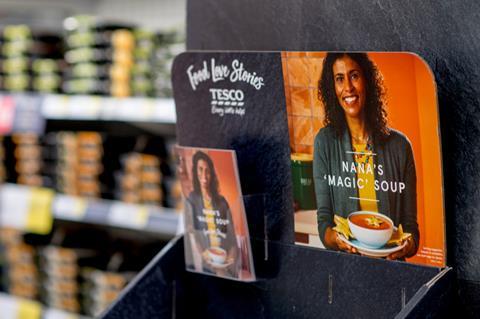
Tesco’s Food Love Stories campaign has been running for six years, and it already feels like part of the nation’s cultural furniture – as reliable and homely as the recipes it spotlights.
But lately it’s been raising its game. The wizards at advertising agency BBH and the marketing team at Tesco have been hitting the spot again and again with their recent ads, from January’s story of a new baby to the latest Ramadan-themed ad, in which a young boy waits for the moment he can get stuck into mum’s delicious samosas.
When it launched in 2017, as part of Tesco’s hugely successful turnaround in the late 2010s, the emphasis in Food Love Stories was very much on the food. The idea was to rekindle the association between Tesco and food quality, so the ads focused on the mouth-watering dishes more than the people making them.
The people were still important, though. In fact, they were key to Tesco and BBH’s strategy. Tesco needed to reconnect with its customers and, as one of the UK’s biggest brands, “its customers” meant almost everyone in the country.
A big-budget, emotional campaign could have reached millions. But to rebuild trust and real connection, Tesco knew it had to avoid feeling generic and inauthentic, which is a risk when you make work designed to appeal to everyone. Instead, it would forge that connection by making adverts for ‘someone’. Lots of different someones.
Each Food Love Stories ad worked to connect with a small section of Tesco’s mass audience, but there were so many that each viewer was bound to find some that resonated. The variety and recipes reflected the range available in Tesco’s stores, but also the diversity of the country it feeds.
The campaign contributed to the brand’s remarkable return to profit and retail dominance in the late 2010s. The ads worked as a collection – however, while individual ads performed well, they rarely hit the very highest scores on System1’s Test Your Ad platform, which predicts the potential a commercial has to drive long-term growth. That wasn’t a big surprise, as Tesco wasn’t trying to make the kind of five-star hero ads other brands build campaigns around.
In the last couple of years, though, Tesco’s ads have started to hit those four and five-star scores on Test Your Ad, giving a new lease of life to the Food Love Stories concept. The emphasis has subtly shifted to make the ‘stories’ part as important as the ‘food’. The recipes still play a vital role, but the ads now are about the family stories and context around that food, with fewer direct-to-camera speeches and a more naturalistic approach to storytelling.
Its latest ad is a great example. A Muslim mum is making samosas for Eid Al-Fitr, the celebration at the end of the holy month of Ramadan. Her son knows how delicious they’re going to taste, but he also knows he can’t tuck in until the new moon marks the end of Ramadan fasting. We see him out in the garden with his binoculars, desperately looking for a trace of it. Eventually the new moon arrives and the Eid celebrations begin – but the kid has tired himself out!
The ad is full of storytelling, human interest and family love, as well as cultural references – all things that draw the ‘broad-beam’ attention of the right side of our brains, and all elements that make for more effective ads. It gets average scores on Test Your Ad among a more general UK audience. There’s no negativity, but inevitably some people don’t understand the culturally specific elements like the significance of the moon.
Show the ad to an audience that does get those things – British Muslims – and the effectiveness scores explode, hitting a top-rated 5.9-star score among a Muslim sample. As well as loving the story in its own right and sympathising with the boy, Muslim viewers were impressed Tesco was making an ad for Ramadan at all, let alone such a sensitively handled one.
At System1 we’ve seen this pattern before. In our 2021 Feeling Seen report, we identified the idea of a ‘diversity dividend’, when an ad performs averagely or well among a wider audience, but the group actually featured in the commercial loves it, and effectiveness jumps up for them. Feeling seen feels good. In 2022 we re-ran the study for the US market and discovered yet again that diverse advertising unites us. When brands make an effort to address diversity, the ads they make are more effective than their average commercial among the whole audience.
Tesco’s Ramadan ad fits the ‘feeling seen’ model perfectly – a pleasant ad for the general audience turns into a big effectiveness winner among the group it represents. But this concept – making an ad for somebody that anybody can also enjoy – is exactly the idea Tesco’s Food Love Stories was built on. You can best reflect the diversity of British lives by making ads about individuals, not trying to be all things to all people.
Tesco’s Ramadan ad represents the best aspects of the old and new Food Love Stories. It embraces one specific story with no compromises, and delights people who recognise it. But it’s also a great example of how the campaign has moved away from recipes into telling stories about the lives those recipes are part of. Mouth-watering, inclusive, and effective too – now that’s a recipe to be proud of.



















No comments yet